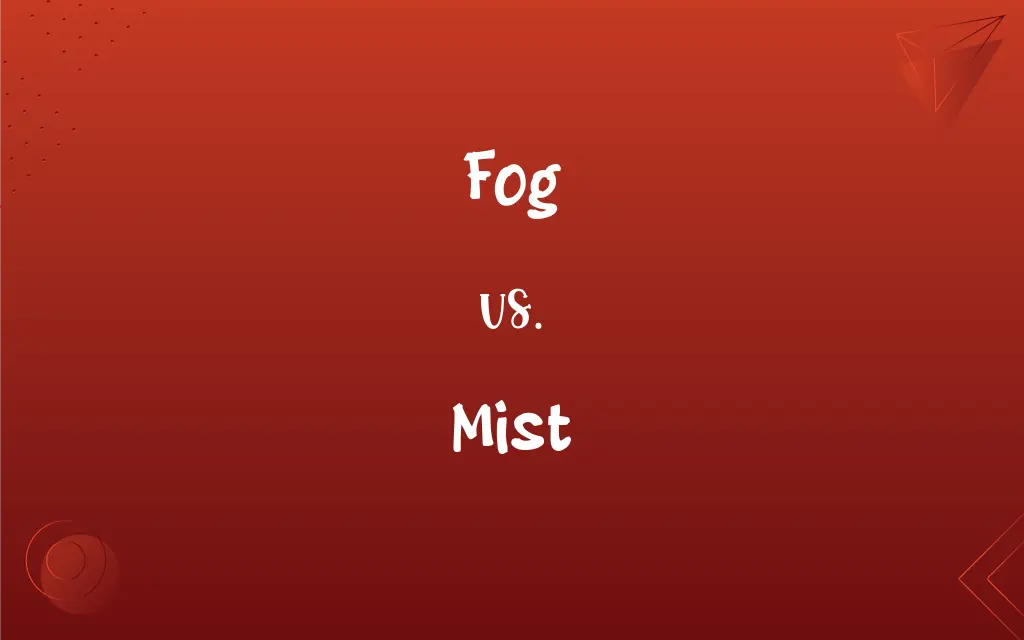Fog vs. Mist: What's the Difference?
Edited by Janet White || By Harlon Moss || Updated on October 23, 2023
Fog is a thick cloud of tiny water droplets near the ground, reducing visibility more than mist, which is lighter and less obscuring.

Key Differences
Fog is a dense accumulation of tiny water droplets suspended in the atmosphere close to the Earth's surface, often severely restricting visibility. Conversely, mist is a thinner collection of these droplets, causing only slight visibility reduction.
When driving in conditions with fog, it's common to use fog lights due to the significantly reduced visibility. In contrast, during mist, regular headlights are often sufficient since the droplets disperse light less intensively.
Areas prone to fog often experience it due to specific geographic, climatic, or environmental factors, such as coastal regions or valleys. On the other hand, mist is more commonly associated with mornings or times following light precipitation.
While both fog and mist are formed under conditions of high relative humidity, fog typically occurs when the difference between the temperature and dew point is less than 2.5°C (4.5°F). Mist, however, can form even when this difference is slightly larger.
People often describe fog as giving a mysterious or eerie ambiance to landscapes because of its denseness. Mist, being less dense, lends a more gentle and ethereal quality to surroundings.
ADVERTISEMENT
Comparison Chart
Density
Dense accumulation of droplets.
Lighter collection of droplets.
Visibility Reduction
Reduces visibility significantly.
Only slightly reduces visibility.
Formation Conditions
Often specific to regions or environmental factors.
Commonly after light rain or in mornings.
Temperature & Dew Point
Difference less than 2.5°C (4.5°F).
Can form with slightly larger temperature-dew point difference
Ambiance
Often described as eerie or mysterious.
Gives a gentle, ethereal quality to surroundings.
ADVERTISEMENT
Fog and Mist Definitions
Fog
Atmospheric moisture that hinders visibility.
Fog delayed many flights at the airport.
Mist
Can cool and moisten surroundings.
The mist from the waterfall was refreshing.
Fog
Dense cloud of water droplets near the ground.
The city was enveloped in a thick fog this morning.
Mist
Fine spray of water droplets in the air.
The early morning mist settled on the fields.
Fog
Caused by the condensation of water vapor.
Cold fronts often lead to fog in coastal areas.
Mist
Often formed after light rain or near water bodies.
Post-rain, the forest was filled with a gentle mist.
Fog
Typically appears in specific geographic regions.
San Francisco is known for its iconic fog.
Mist
Lighter than fog and less obscuring.
The mountains were faintly visible through the mist.
Fog
Represents reduced visibility conditions.
Driving in fog requires extra caution and attention.
Mist
Gives an ethereal ambiance to landscapes.
The mist over the lake added to the scene's serenity.
Fog
Condensed water vapor in cloudlike masses lying close to the ground and limiting visibility.
Mist
A mass of fine droplets of water in the atmosphere near or in contact with the earth.
FAQs
When is mist commonly observed?
Mist is often observed in the mornings or after light rainfall.
Is mist thicker than fog?
No, mist is lighter and less obscuring than fog.
Can fog affect transportation?
Yes, fog can significantly reduce visibility, affecting road, air, and sea travel.
Does fog always stay near the ground?
While fog typically forms near the ground, it can sometimes rise, depending on temperature conditions.
What is fog typically composed of?
Fog consists of tiny water droplets suspended in the air near the ground.
Does mist always precede fog?
No, while mist can develop into fog under certain conditions, it doesn't always precede fog.
Does mist always indicate colder weather?
No, mist can form in various temperatures, and it's the moisture and relative humidity that play key roles.
Is fog harmful to health?
Generally, no. But fog mixed with pollutants can create "smog," which can be harmful.
Is there a specific humidity level for mist formation?
Mist generally forms under high humidity conditions, similar to fog, but exact levels can vary.
How can drivers safely navigate through fog?
In fog, drivers should reduce speed, use fog lights, and maintain a safe distance from other vehicles.
Are fog and mist only composed of water?
Primarily, yes. Both fog and mist consist of water droplets, though pollutants can sometimes be mixed in.
How do photographers use mist in their shots?
Mist can lend a soft, ethereal quality, making landscapes and subjects appear dreamy or mysterious.
Is mist always visible?
While mist is generally visible, its intensity can vary, making it more prominent in some conditions.
Can mist be artificially created?
Yes, mist can be artificially created using misting systems, often seen in greenhouses or patios.
What's the main difference between fog and mist regarding visibility?
Fog reduces visibility more significantly than mist due to its denser nature.
Why might someone prefer a misty day over a foggy one?
A misty day might be preferred as it offers better visibility and a gentler ambiance compared to the denseness of fog.
Can fog form indoors?
Yes, fog can form in cold storage facilities or when warm, moist air meets a cold surface.
Can fog machines replicate natural fog?
Fog machines can produce a similar appearance to natural fog, but the composition and mechanism are different.
Why does San Francisco experience frequent fog?
Coastal currents and specific geographic factors lead to regular fog formation in San Francisco.
Do fog and mist affect humidity levels?
Yes, the presence of fog and mist indicates high relative humidity in the atmosphere.
About Author
Written by
Harlon MossHarlon is a seasoned quality moderator and accomplished content writer for Difference Wiki. An alumnus of the prestigious University of California, he earned his degree in Computer Science. Leveraging his academic background, Harlon brings a meticulous and informed perspective to his work, ensuring content accuracy and excellence.
Edited by
Janet WhiteJanet White has been an esteemed writer and blogger for Difference Wiki. Holding a Master's degree in Science and Medical Journalism from the prestigious Boston University, she has consistently demonstrated her expertise and passion for her field. When she's not immersed in her work, Janet relishes her time exercising, delving into a good book, and cherishing moments with friends and family.































































